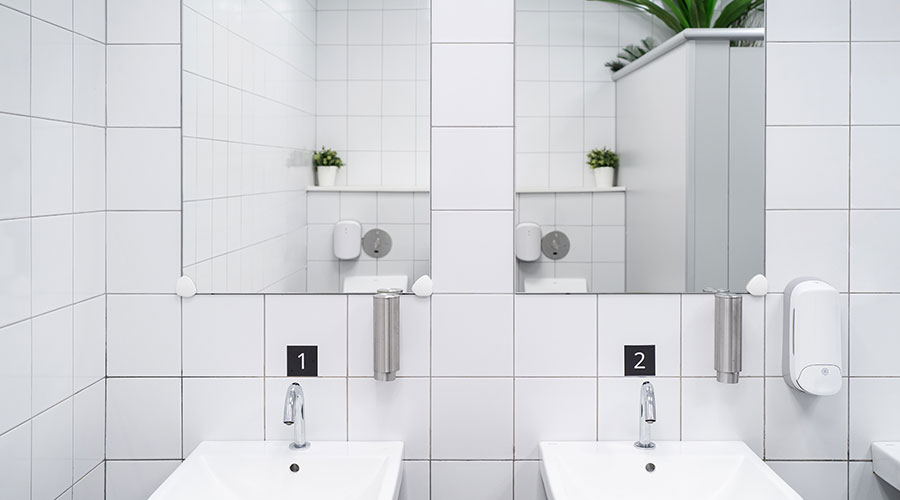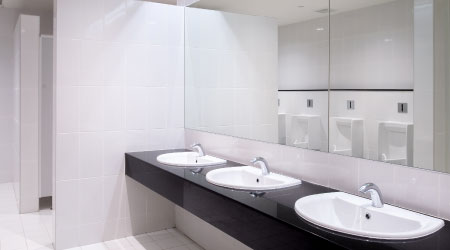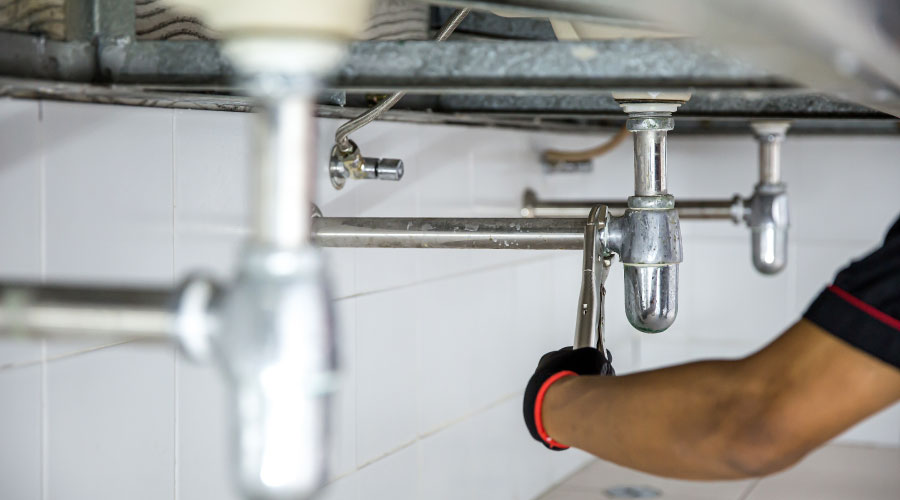Technology@Work: Touchless Plumbing
One organization learns valuable lessons about ensuring today’s touchless technology delivers benefits to facilities
Over the past 20 years, manufacturers have made major advances in improving the ease of use and water efficiency of restroom fixtures. Bringing those technologies into an existing facility, however, can create a host of challenges. Just ask George Horn, manager of operations and maintenance at Chevron Real Estate Management in San Ramon, Calif. For the past three years, his department has been renovating about one-half of the 55 restrooms at the organization’s headquarters buildings.
Horn, who plans to eventually renovate all of the organization’s restrooms, has been overseeing the specification of the projects’ equipment and materials, including tiles, lighting fixtures, and plumbing fixtures.
“One of my jobs is to keep the architects in line because I have to maintain what they leave me,” he says.
It was important to Horn that the renovated restrooms feature touchless faucets, toilets and urinals because he was confident that specifying and installing such fixtures would both lower maintenance costs and improve overall accessibility for visitors.
Identifying Needs
The site was built in 1985, and while 20 years might not seem that long for a building, Horn says the original washer-type restroom fixtures had become problematic and required increased maintenance.
Before renovations began, workers also discovered that water had seeped behind walls in restrooms with shower stalls. The problem was caused by the original design of the restrooms.
“Because there was no shower pan, the water was going into the drain and finding its way under the walls and creating conditions that could produce mold and mildew,” he says. Besides fixing these problems, the renovations also needed to bring the restrooms in compliance with Americans with Disabilities Act (ADA) access guidelines.
“We had to change the distance between the urinals and the distance between the toilets in order to gain the proper dimensions for ADA,” Horn says. For these reasons, it made more sense to completely gut the restrooms and start over instead of trying to carry out a limited renovation. The renovations provided an excellent opportunity to specify and install touchless urinals and faucets.
“I leaned on the project managers and the design team and said ‘Here is an excellent opportunity to move to automatic flushers and faucets,’ ” he says. “Public locations from Disneyland to local airports have touchless fixtures. They reduce maintenance costs and water use and appear to be a better way to go.” Horn also sought durability.
“I wanted all-steel bodies and something that was going to withstand the abuse that a lot a people can give to a fixture,” he says.
Trial and Error
For the first several renovations, Horn specified fixtures featuring electric solenoids and top-mount flush systems. Within a 18 months after the installations, however, several of these systems had failed.
After noting that urinals featuring side-mount systems continued to operate properly, Horn suspected the failures were the result of the the design of the top-mount systems. He discovered that water intrusion in the top-mount units was causing the solenoid to fail. This problem diminished the life of the battery, and it damaged the unit’s seal. To fix the problem, technicians needed to rebuild the entire unit.
“We found that the rebuild kit was almost as expensive as buying a new flushometer,” Horn says. So he began looking for other solutions.
He says the best alternative he could find was installing units with gear-driven, side-mount automatic flush systems that still use traditional flushometers.
“That way, if we needed to rebuild, it would cost 12 bucks, rather than $200 or more for a whole new flush valve,” he says. “That was a learning experience for us.”
So far, the gear-driven, side-mount units have performed very well, he says.
“Another nice thing about the side-mount systems is that if the unit fails totally, all you have to do is take it off and put the handle back on,” Horn says. “The side-mount system takes the place of the handle. All you have to do is take that nut off that has the handle on it and put the side mount on, and it works the same way that the handle does.”
Another benefit of this remedy is that technicians don’t need to replace the original flush valve.
“With the top-mount systems, you have the replace the flush valve in its entirety,” he says. “So when you do get a failure of the entire unit, it can cost you a whole lot more than just putting the handle back.” Because of the maintenance problems created by the top-mount systems, Horn now specifies only side-mount systems.
Faucet Focus
While the touchless faucets Horn specified have caused few maintenance problems, installing them created challenges for technicians.
“You think one size fits all, but each installation is a little different because they’re based on how far away your hot water is from your faucet,” he says. The biggest challenge was arranging to get hot water to the sink in a short amount of time.
“We’ve got about 10 feet from the hot-water and cold-water pipes for the feed lines that come down to the faucet,” Horn says. “It took too long to get the warm water down there. Even though the warm water circulates in the main line, getting it down the branch lines took forever.”
To solve the problem, technicians installed a device similar to a circuit limiter.
“The water now comes down and cycles through the branch lines and back up,” Horn says. “Now, when you put your hand under the faucet, you can get warm water within a couple of seconds. It works a lot better.” Horn says none of the touchless faucets have failed.
More Touchless Options
Horn also is experimenting with additional touchless restroom products, including soap and towel dispensers.
For automatic soap dispensers, he says, “you have to find a nice combination between your soap and the dispenser so it doesn’t get too thick and cause problems.” Unable to find that combination, he says the maintenance workers reinstalled traditional push-type fixtures.
While Horn hasn’t specified automatic towel dispensers for the restrooms yet, he is trying them in the facility’s coffee rooms and kitchens.
“So far, so good,” he says. “I was kind of surprised. I thought they would start to become a maintenance problem. They are actually pretty solid.”
Horn says he is willing to try any product or system that has potential money-saving benefits for the organization. For example, he is interested in the potential water-saving opportunity that waterless urinals offer.
Says Horn, “I would like to try one to see how they work, but I haven’t had the opportunity yet.”
Power Issue: Battery or Hard-wired?
The University of Utah in Salt Lake City has installed numerous touchless fixtures in restrooms throughout its campus.
But a considerable difference exists between the battery-operated and hard-wired systems, says Pieter van der Have, the university’s assisstant president of plant operations.
“The ones that are hard-wired into new buildings seem to be working really well,” he says. “They don’t seem to have a lot of maintenance issues associated with them. Also, there doesn't seem to be an increase in operation and maintenance costs.”
On the other hand, battery-operated models have been more expensive to maintain, he says, adding that most of these costs are associated with the units’ batteries.
Changing the battery, he says, “doesn't always get done when it should, so we have situations where they don’t work.” Another reoccurring problem arises when occupants fail to notify the maintenance department when these units fail.
Despite these issues, battery-operated units can be useful, particularly in high-traffic areas.
Using these units, he says, creates “an impression that the facilities are better maintained, especially in the larger event centers.”
Before specifying these units, van der Have says, managers “really need to look at the frequency of use of the facility (and) take a look at how the custodial staff cleans the fixtures and at the durability of the particular model they’re considering.”
— Renee L. Shroades
|
Addressing Drain Dilemmas
Most of the time, facility occupants and visitors don’t notice the drains in their facilities. When a drain-related problem arises, however, it often becomes a top priority for maintenance departments.
For clearing clogs, managers need to consider their options for determining the most effective solution.
“We have relatively small, portable drain-cleaning units,” says Pieter van der Have, assistant president of plant operations for the University of Utah in Salt Lake City. “If we have a more significant problem, we’ll usually bring in a contractor who specializes in that kind of service with a high-pressure device. We used to have our own unit, and we found that the times we needed it, it wasn’t working right. We still ended up hiring a contractor.”
For some drain problems, managers might consider units with fiberoptic cameras to uncover the cause of a problem.
“In the older part of campus, we had a number of issues with roots and collapsed systems, and we have found those cameras to be very, very useful,” van der Have says. “We’ve used them for all sorts of problems, like sewers, collapsed water lines and electrical conduits.” Odor is another common drain problem.
“We had an odor problem because the traps would dry out,” says George Horn, manager of operations and maintenance at Chevron Real Estate Management in San Ramon, Calif. The dryness allowed sewer gas to enter restrooms. To solve the problem, maintenance workers use to pour a small amount of bleach and water down the drain.
Horn says a better solution was installing trap primers.
“Every time a toilet or urinal flushes, the device releases a little bit of water into the trap,” he says. “It is an automatic way of keeping the trap full of water.”
— Renee L. Shroades
|
Related Topics:











